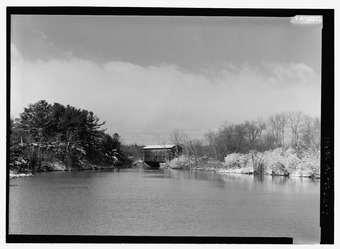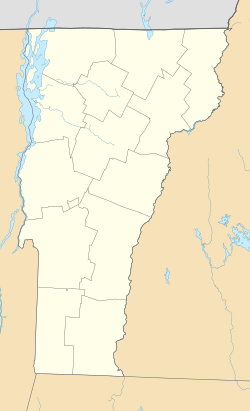East Shoreham Covered Railroad Bridge facts for kids
Quick facts for kids |
|
|
East Shoreham Covered Railroad Bridge
|
|

2003 HABS/HAER photo
|
|
| Location | SE of Shoreham over Lemon Fair River, Shoreham, Vermont |
|---|---|
| Area | 1 acre (0.40 ha) |
| Built | 1897 |
| Built by | Rutland Railroad Company |
| NRHP reference No. | 74000198 |
| Added to NRHP | June 13, 1974 |
The East Shoreham Covered Railroad Bridge is a really old and special bridge in Shoreham, Vermont. It crosses the Lemon Fair River. This bridge was built way back in 1897 by the Rutland Railroad Company. It's super unique because it's the only wooden covered bridge left in Vermont that used a special design called a "Howe truss" for trains. Because it's so important, it was added to the National Register of Historic Places in 1974.
Contents
Discover the East Shoreham Bridge
The East Shoreham Bridge is found in a quiet, country part of southeastern Shoreham. It stretches over the Lemon Fair River. You can find it about 0.2 miles (0.3 km) west of Shoreham-Depot Road. It's a great place to visit on foot, as the old railroad path and the bridge are now owned by the state.
How Was This Bridge Built?
This bridge is a single-span structure. It uses a special design called a Howe truss. It is about 109 feet (33 meters) long. The bridge rests on stone supports that are faced with concrete.
The Howe truss design uses wooden beams that go diagonally. It also has strong iron rods that go straight up and down. The bridge is about 20 feet (6.1 meters) wide on the outside. Inside, it's about 13.5 feet (4.1 meters) wide. The train tracks used to sit right on the wooden floor of the bridge. The outside of the bridge is covered with vertical wooden boards. It also has a metal roof to protect it.
Why is This Bridge Special?
The Rutland Railroad Company built this bridge in 1897. It was part of their Addison Branch line. This train line didn't have a lot of traffic. So, the company didn't need to spend extra money on a metal bridge. This is why they built a wooden covered bridge instead. This makes it one of the few covered railroad bridges from the 1800s that is still standing in Vermont.
The bridge was used by trains until 1951. That's when the train line was no longer used. In 1972, the state of Vermont bought the bridge and the land around it. It's now a historic landmark for everyone to enjoy!
Images for kids




